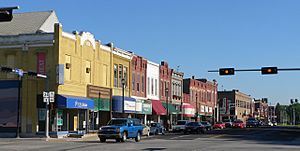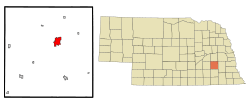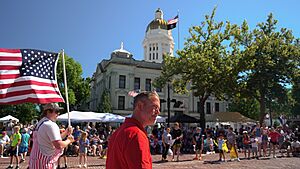Seward, Nebraska facts for kids
Quick facts for kids
Seward, Nebraska
|
|
|---|---|

Downtown Seward: west side of courthouse square, July 2010
|
|

Location of Seward within Seward County and Nebraska
|
|
| Country | United States |
| State | Nebraska |
| County | Seward |
| Area | |
| • Total | 4.49 sq mi (11.63 km2) |
| • Land | 4.46 sq mi (11.54 km2) |
| • Water | 0.04 sq mi (0.09 km2) |
| Elevation | 1,493 ft (455 m) |
| Population
(2020)
|
|
| • Total | 7,643 |
| • Density | 1,715.22/sq mi (662.31/km2) |
| Time zone | UTC-6 (Central (CST)) |
| • Summer (DST) | UTC-5 (CDT) |
| ZIP code |
68434
|
| Area code(s) | 402 |
| FIPS code | 31-44420 |
| GNIS feature ID | 2396580 |
| Website | cityofsewardne.com |
Seward is a city in Nebraska, United States. It is also the main town, or county seat, of Seward County, Nebraska. In 2020, about 7,643 people lived here. Seward is part of the larger Lincoln area.
Contents
Seward's History: How It Started
Seward was planned out in 1868. This means its streets and lots were laid out. The city got its name from Seward County. A railroad was built through Seward in 1873. This helped the town grow.
Geography: Where Seward Is Located
Seward is in the state of Nebraska. The city covers a total area of about 4.31 square miles (11.16 square kilometers). Most of this area is land, with a small part being water.
Seward's Climate: Weather Patterns
Seward has a climate with warm summers and cold winters. The hottest month is usually July, and the coldest is January. The city gets a good amount of rain, especially in late spring and early summer. Snowfall is common in winter.
| Climate data for Seward, Nebraska (1991–2020 normals, extremes 1900–present) | |||||||||||||
|---|---|---|---|---|---|---|---|---|---|---|---|---|---|
| Month | Jan | Feb | Mar | Apr | May | Jun | Jul | Aug | Sep | Oct | Nov | Dec | Year |
| Record high °F (°C) | 74 (23) |
80 (27) |
90 (32) |
98 (37) |
103 (39) |
107 (42) |
114 (46) |
111 (44) |
105 (41) |
98 (37) |
87 (31) |
81 (27) |
114 (46) |
| Mean daily maximum °F (°C) | 32.9 (0.5) |
37.6 (3.1) |
50.0 (10.0) |
61.5 (16.4) |
71.9 (22.2) |
81.9 (27.7) |
85.7 (29.8) |
83.8 (28.8) |
77.5 (25.3) |
64.8 (18.2) |
49.6 (9.8) |
36.2 (2.3) |
61.1 (16.2) |
| Daily mean °F (°C) | 22.5 (−5.3) |
26.8 (−2.9) |
38.3 (3.5) |
49.6 (9.8) |
61.0 (16.1) |
71.4 (21.9) |
75.4 (24.1) |
73.1 (22.8) |
65.3 (18.5) |
52.0 (11.1) |
38.0 (3.3) |
26.2 (−3.2) |
50.0 (10.0) |
| Mean daily minimum °F (°C) | 12.0 (−11.1) |
16.1 (−8.8) |
26.6 (−3.0) |
37.6 (3.1) |
50.2 (10.1) |
60.9 (16.1) |
65.2 (18.4) |
62.4 (16.9) |
53.0 (11.7) |
39.3 (4.1) |
26.4 (−3.1) |
16.2 (−8.8) |
38.8 (3.8) |
| Record low °F (°C) | −30 (−34) |
−26 (−32) |
−19 (−28) |
5 (−15) |
19 (−7) |
36 (2) |
42 (6) |
37 (3) |
20 (−7) |
6 (−14) |
−6 (−21) |
−27 (−33) |
−30 (−34) |
| Average precipitation inches (mm) | 0.65 (17) |
0.67 (17) |
1.49 (38) |
2.46 (62) |
4.87 (124) |
4.70 (119) |
3.56 (90) |
3.46 (88) |
2.46 (62) |
2.20 (56) |
1.23 (31) |
0.92 (23) |
28.67 (728) |
| Average snowfall inches (cm) | 5.4 (14) |
6.0 (15) |
3.0 (7.6) |
0.9 (2.3) |
0.0 (0.0) |
0.0 (0.0) |
0.0 (0.0) |
0.0 (0.0) |
0.0 (0.0) |
0.7 (1.8) |
1.5 (3.8) |
4.0 (10) |
21.5 (55) |
| Average precipitation days (≥ 0.01 in) | 4.6 | 4.5 | 6.4 | 9.2 | 10.8 | 9.0 | 7.8 | 7.8 | 6.8 | 6.5 | 4.1 | 3.9 | 81.4 |
| Average snowy days (≥ 0.1 in) | 3.2 | 3.1 | 1.6 | 0.5 | 0.0 | 0.0 | 0.0 | 0.0 | 0.0 | 0.1 | 1.4 | 2.8 | 12.7 |
| Source: NOAA | |||||||||||||
Demographics: Who Lives in Seward?
The population of Seward has grown over the years. Here's a look at how many people have lived in the city:
| Historical population | |||
|---|---|---|---|
| Census | Pop. | %± | |
| 1880 | 1,525 | — | |
| 1890 | 2,108 | 38.2% | |
| 1900 | 1,970 | −6.5% | |
| 1910 | 2,106 | 6.9% | |
| 1920 | 2,368 | 12.4% | |
| 1930 | 2,737 | 15.6% | |
| 1940 | 2,826 | 3.3% | |
| 1950 | 3,154 | 11.6% | |
| 1960 | 4,208 | 33.4% | |
| 1970 | 5,294 | 25.8% | |
| 1980 | 5,713 | 7.9% | |
| 1990 | 5,634 | −1.4% | |
| 2000 | 6,319 | 12.2% | |
| 2010 | 6,964 | 10.2% | |
| 2020 | 7,643 | 9.8% | |
| U.S. Decennial Census | |||
2020 Census: A Closer Look
In 2020, the 2020 United States census counted 7,643 people in Seward. There were 2,672 households and 1,705 families. Most people living in Seward were white (93.31%). Other groups included African American, Native American, and Asian people. About 3.0% of the population was Hispanic or Latino.
Many households (30.7%) had children under 18. Over half (53.1%) were married couples living together. About 15.8% of households had someone aged 65 or older living alone. The average household had 2.3 people. The average family had 2.9 people.
The median age in Seward was 31.6 years. This means half the people were younger and half were older. About 20.5% of the population was under 18. About 14.9% were 65 or older.
2010 Census: What the Numbers Showed
The 2010 census found 6,964 people living in Seward. There were 2,521 households. Most residents (96.8%) were White. Other groups included African American, Native American, and Asian people. About 1.9% of the population was Hispanic or Latino.
About 32.1% of households had children under 18. Many households (55.0%) were married couples. About 30.2% of households had only one person living there. The average household size was 2.39 people.
The median age was 32.4 years. About 22.6% of residents were under 18. About 15.1% were 65 or older. The city had slightly more females (51.9%) than males (48.1%).
Fourth of July City: Seward's Big Celebration
Seward is famous for its Fourth of July celebrations. They have held these celebrations almost every year since 1868. In the past, special trains brought people to the event.
In 1973, the Governor of Nebraska officially named Seward "Nebraska's Official 4th of July City." Then, in 1976, Seward hosted Nebraska's July 4th celebrations for the United States Bicentennial. This was a big event marking 200 years of the United States.
In 1979, the US Congress gave Seward another special title. They named it "America's Official Fourth of July City—Small Town USA." Today, about 40,000 people come to Seward for the Fourth of July.
Education: Learning in Seward
Seward has several schools for students. Seward Public Schools is the main public school district. It includes Seward Elementary School, Seward Middle School, and Seward High School.
There are also private schools. St. John Lutheran Elementary and Junior High School offers a Lutheran education. St. Vincent de Paul provides a Roman Catholic education.
For higher education, Concordia University is located in Seward. It is a university where students can earn college degrees.
Economy: Jobs and Businesses
Seward has several important employers that provide jobs for many people. These include Tenneco, a large company. Concordia University, Nebraska is also a major employer.
Other key businesses are Hughes Brothers Inc. and Seward Memorial Hospital. The hospital is part of Memorial Health Care Systems. These businesses help the local economy.
Sports: Baseball History
Seward once had its own minor league baseball team. From 1910 to 1913, the Seward Statesmen played in the Class D level Nebraska State League.
In May 1913, a strong tornado hit Seward. Because of this, the baseball team had to move during the season. They became the Beatrice Milkskimmers. The Seward Statesmen played their home games at Fairgrounds Park.
Notable people
- Seth Christian, a filmmaker
- Theodore C. Diers, who was a state representative and senator in Wyoming
- John Folda, a bishop in the Roman Catholic Diocese of Fargo
- Joel D. Heck, a Lutheran theologian
- Qveen Herby, (Amy Renee Heidemann Noonan) a rapper and singer
- Sam Koch, a professional football player
- Mark Kolterman, a state legislator in Nebraska
- Reinhold Marxhausen, an artist
- Quentin Neujahr, a professional football player
- Andrea von Kampen, a musician
- Francis Vreeland, a painter
- Thad Weber, a baseball player
- Bub Weller, a professional football player
See also
 In Spanish: Seward (Nebraska) para niños
In Spanish: Seward (Nebraska) para niños


